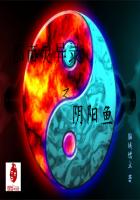OROGRAPHIC DETAILS
The course taken by the projectile, as we have before remarked, was bearing it toward the moon's northern hemisphere. The travelers were far from the central point which they would have struck, had their course not been subject to an irremediable deviation.
It was past midnight; and Barbicane then estimated the distance at seven hundred and fifty miles, which was a little greater than the length of the lunar radius, and which would diminish as it advanced nearer to the North Pole. The projectile was then not at the altitude of the equator; but across the tenth parallel, and from that latitude, carefully taken on the map to the pole, Barbicane and his two companions were able to observe the moon under the most favorable conditions. Indeed, by means of glasses, the above-named distance was reduced to little more than fourteen miles. The telescope of the Rocky Mountains brought the moon much nearer; but the terrestrial atmosphere singularly lessened its power. Thus Barbicane, posted in his projectile, with the glasses to his eyes, could seize upon details which were almost imperceptible to earthly observers.
"My friends," said the president, in a serious voice, "I do not know whither we are going; I do not know if we shall ever see the terrestrial globe again. Nevertheless, let us proceed as if our work would one day by useful to our fellow-men. Let us keep our minds free from every other consideration. We are astronomers; and this projectile is a room in the Cambridge University, carried into space. Let us make our observations!"This said, work was begun with great exactness; and they faithfully reproduced the different aspects of the moon, at the different distances which the projectile reached.
At the time that the projectile was as high as the tenth parallel, north latitude, it seemed rigidly to follow the twentieth degree, east longitude. We must here make one important remark with regard to the map by which they were taking observations. In the selenographical maps where, on account of the reversing of the objects by the glasses, the south is above and the north below, it would seem natural that, on account of that inversion, the east should be to the left hand, and the west to the right. But it is not so. If the map were turned upside down, showing the moon as we see her, the east would be to the left, and the west to the right, contrary to that which exists on terrestrial maps. The following is the reason of this anomaly. Observers in the northern hemisphere (say in Europe) see the moon in the south-- according to them.
When they take observations, they turn their backs to the north, the reverse position to that which they occupy when they study a terrestrial map. As they turn their backs to the north, the east is on their left, and the west to their right. To observers in the southern hemisphere (Patagonia for example), the moon's west would be quite to their left, and the east to their right, as the south is behind them. Such is the reason of the apparent reversing of these two cardinal points, and we must bear it in mind in order to be able to follow President Barbicane's observations.
With the help of Boeer and Moedler's _Mappa Selenographica_, the travelers were able at once to recognize that portion of the disc enclosed within the field of their glasses.
"What are we looking at, at this moment?" asked Michel.
"At the northern part of the `Sea of Clouds,'" answered Barbicane.
"We are too far off to recognize its nature. Are these plains composed of arid sand, as the first astronomer maintained?
Or are they nothing but immense forests, according to M. Warren de la Rue's opinion, who gives the moon an atmosphere, though a very low and a very dense one? That we shall know by and by.
We must affirm nothing until we are in a position to do so."This "Sea of Clouds" is rather doubtfully marked out upon the maps.
It is supposed that these vast plains are strewn with blocks of lava from the neighboring volcanoes on its right, Ptolemy, Purbach, Arzachel. But the projectile was advancing, and sensibly nearing it. Soon there appeared the heights which bound this sea at this northern limit. Before them rose a mountain radiant with beauty, the top of which seemed lost in an eruption of solar rays.
"That is--?" asked Michel.
"Copernicus," replied Barbicane.
"Let us see Copernicus."
This mount, situated in 9@ north latitude and 20@ east longitude, rose to a height of 10,600 feet above the surface of the moon. It is quite visible from the earth; and astronomers can study it with ease, particularly during the phase between the last quarter and the new moon, because then the shadows are thrown lengthways from east to west, allowing them to measure the heights.















